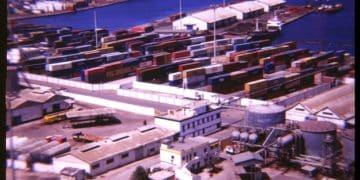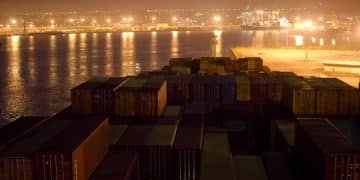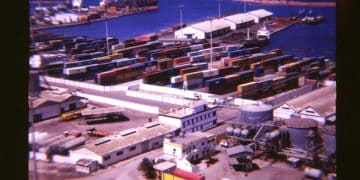USMCA Rules of Origin: Your Guide to Zero Tariffs in 2025

Navigating the USMCA Rules of Origin is crucial for US companies aiming to leverage zero tariffs in 2025, requiring a detailed understanding of regional value content, tariff shift rules, and specific documentation to ensure compliance and maximize benefits.
Unlocking zero tariffs under the United States-Mexico-Canada Agreement (USMCA) requires a thorough understanding of its rules of origin. This practical guide walks you through the complexities of navigating the USMCA Rules of Origin: A Practical Guide to Qualifying for Zero Tariffs in 2025, ensuring your products meet the requirements for duty-free treatment.
Understanding the USMCA and Its Significance
The USMCA, which replaced NAFTA, aims to promote fair trade and economic growth among the United States, Mexico, and Canada. At the heart of this agreement are the rules of origin, which dictate the conditions under which goods qualify for preferential tariff treatment. These rules are essential for preventing non-member countries from taking advantage of the agreement by simply routing goods through a USMCA country.
For businesses, understanding these rules is not just about compliance; it’s about strategic advantage. Qualifying your products for zero tariffs can significantly reduce costs, improve competitiveness, and expand market access within the USMCA region.
Key Objectives of the USMCA Rules of Origin
- Ensuring that the benefits of the USMCA accrue primarily to goods produced in North America.
- Preventing circumvention of trade remedies and safeguards.
- Providing clear and predictable rules for businesses to follow.
- Promoting regional economic integration and supply chain development.
Successfully leveraging the USMCA requires more than just a cursory understanding of its provisions. It demands a detailed knowledge of the specific rules applicable to your industry and products, as well as a commitment to maintaining accurate records and documentation.

Decoding the Key Concepts of USMCA Rules of Origin
To successfully navigate the USMCA rules of origin, you need to understand several key concepts. These concepts determine whether your products are eligible for preferential tariff treatment. Let’s break down some of the most important ones.
The USMCA uses two primary methods for determining origin: regional value content and tariff shift rules. Each method has its own set of requirements and considerations.
Regional Value Content (RVC)
RVC refers to the portion of a product’s value that originates within the USMCA region. There are two main methods for calculating RVC: the transaction value method and the net cost method.
- Transaction Value Method: Calculates RVC based on the price paid or payable for the good.
- Net Cost Method: Calculates RVC based on the total cost of producing the good, subtracting certain expenses such as royalties and sales promotion costs.
Tariff Shift Rules
Tariff shift rules specify that a product qualifies for preferential treatment if non-originating materials undergo a specified change in tariff classification as a result of production in a USMCA country. These rules are product-specific and can be quite complex.
Successfully applying these concepts requires a meticulous approach to tracking costs, materials, and production processes. Understanding which method is most advantageous for your products is a critical step in qualifying for zero tariffs.
Step-by-Step Guide to Determining Origin
Determining the origin of your products under the USMCA involves a series of steps. Each step requires careful attention to detail and a thorough understanding of the applicable rules.
This process is not always straightforward, and it may require consulting with customs experts or trade advisors.
Step 1: Classify Your Product
The first step is to correctly classify your product according to the Harmonized System (HS) code. This classification is essential for determining the applicable rules of origin.
Step 2: Identify the Applicable Rule of Origin
Once you have classified your product, you need to identify the specific rule of origin that applies to that product. This information can be found in the USMCA’s rules of origin annex.
Step 3: Gather Documentation
Gather all necessary documentation to prove that your product meets the applicable rule of origin. This may include invoices, bills of materials, and production records.
By following these steps carefully, you can increase your chances of successfully qualifying your products for zero tariffs under the USMCA. Remember to keep accurate records and consult with experts when needed.

Common Challenges and How to Overcome Them
Navigating the USMCA rules of origin is not without its challenges. Many businesses encounter difficulties in interpreting the rules, gathering the necessary documentation, and ensuring ongoing compliance.
However, with the right strategies and resources, these challenges can be overcome.
Lack of Understanding
One of the most common challenges is a lack of understanding of the complex rules of origin. Many businesses struggle to interpret the specific requirements applicable to their products.
- Solution: Invest in training for your staff, consult with customs experts, and utilize online resources provided by government agencies and trade associations.
Documentation Issues
Another common challenge is related to documentation. Many businesses fail to maintain accurate records or provide sufficient evidence to support their claims of origin.
- Solution: Implement robust record-keeping systems, train your staff on documentation requirements, and conduct regular audits to ensure compliance.
Supply Chain Complexity
Supply chain complexity can also pose a challenge. Many products involve materials and components from multiple countries, making it difficult to determine the origin of the final product.
By addressing these common challenges head-on, businesses can improve their ability to comply with the USMCA rules of origin and take full advantage of the agreement’s benefits. Remember to stay informed, seek expert advice, and prioritize compliance.
Preparing for 2025: Key Strategies for US Businesses
As we move closer to 2025, US businesses need to proactively prepare for the evolving trade landscape under the USMCA. This preparation involves implementing key strategies to ensure ongoing compliance and maximize the benefits of the agreement.
By taking these steps now, businesses can position themselves for success in the years to come.
Conduct a Comprehensive Review
Start by conducting a comprehensive review of your supply chains and production processes. Identify any potential areas of non-compliance and develop strategies to address them.
Invest in Technology
Invest in technology solutions that can help you track and manage your compliance efforts. This may include software for managing documentation, calculating RVC, and monitoring tariff classifications.
Build Strong Relationships
- With suppliers, to ensure they understand and comply with the USMCA rules of origin.
Preparing for 2025 requires a proactive and strategic approach. By conducting a comprehensive review, investing in technology, and building strong relationships, US businesses can position themselves for success under the USMCA.
The Future of USMCA and Rules of Origin
The USMCA is a dynamic agreement that is subject to ongoing review and potential amendments. As such, it’s important to stay informed about any changes to the rules of origin and their potential impact on your business.
The future of the USMCA will likely be shaped by a number of factors, including technological advancements, geopolitical developments, and evolving trade patterns.
Anticipating Future Changes
One of the key challenges for businesses will be anticipating and adapting to future changes in the USMCA rules of origin. This requires a proactive approach to monitoring trade policy and engaging with government agencies and trade associations.
Embracing Technological Innovation
Technological innovation will also play a key role in the future of the USMCA. As new technologies emerge, they may create opportunities to streamline compliance processes, improve supply chain visibility, and reduce costs.
The future of the USMCA is uncertain, but by staying informed, embracing technological innovation, and prioritizing sustainability, businesses can position themselves for long-term success.
| Key Point | Brief Description |
|---|---|
| 🔑 Understand USMCA | Grasp the basics of USMCA and its impact on trade. |
| 📝 RVC and Tariff Shift | Learn RVC calculation and tariff shift rules for compliance. |
| ✅ Compliance Steps | Follow a step-by-step guide to determine product origin. |
| 📊 Future Strategies | Adopt proactive strategies for future USMCA changes. |
Frequently Asked Questions (FAQ)
▼
The USMCA is a trade agreement between the United States, Mexico, and Canada that replaced NAFTA. It aims to promote fair trade, economic growth, and regional integration among the three countries.
▼
To qualify for zero tariffs, your product must meet the USMCA rules of origin. This typically involves meeting regional value content requirements or satisfying tariff shift rules.
▼
Regional value content refers to the portion of a product’s value that originates within the USMCA region. It can be calculated using the transaction value method or the net cost method.
▼
Tariff shift rules specify that a product qualifies for preferential treatment if non-originating materials undergo a specified change in tariff classification as a result of production in a USMCA country.
▼
You can find more information about the USMCA rules of origin on the websites of government agencies such as the U.S. Customs and Border Protection and trade associations.
Conclusion
Navigating the USMCA Rules of Origin is essential for US businesses seeking to leverage zero tariffs in 2025. By understanding the key concepts, following a step-by-step guide, and preparing for future changes, companies can ensure compliance and maximize the benefits of this important trade agreement.





